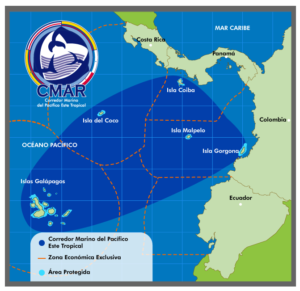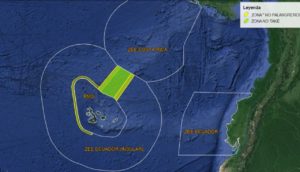Expansion of the Galapagos Marine Reserve and Protection of an Ocean Highway for Marine Wildlife
November 11, 2021; By Carolyn Sotka
Exciting news to expand the Galapagos Marine Reserve (GMR) was announced by the President of Ecuador, Guillermo Lasso, at the COP26 UN Climate Conference this week. The Galapagos Islands are home to nearly 3,000 marine species, of which 20 percent are found nowhere else on earth. The GMR has been protected since 1998 and this expansion will help secure a critical migratory ‘highway’ for marine wildlife. Since 2002, WildAid Marine has partnered with the Ecuadorian Ministry of Environment, the Galapagos National Park Directorate (GNPD), and the Ecuadorian Navy to enforce the laws of the GMR and prevent illegal fishing within its borders.
Gustavo Manrique, Minister of Environment, Water, and Ecological Transition stated, “This new marine reserve expands the current area in 60,000 new sq km and creates a corridor which connects Ecuadorian waters with Costa Rican waters, thus creating a safe swimway where important endangered migratory species, such as sharks, whales, turtles, and manta rays travel.” This new marine reserve will also serve as a living laboratory to conduct scientific research, which will allow a deeper understanding of the biosphere.
Map 1 illustrates the boundary of the GMR (RMG in Spanish); Ecuador’s and Costa Rica’s Exclusive Economic Zone (EEZ/ZEE) and the new 60,000 sq km (23,166 sq mi) corridor linking the two. The inner zone (neon green) represents 30,000 sq km of a no fishing – no take zone. The yellow border/buffer, also 30,000 sq km, has been designated as a no longline fishing zone, which will help to prevent fishing lines from entering the current GMR and better protect sharks and other pelagic species.
The expansion of the GMR will involve the repurchase of Ecuadorian debt bonds by three large international entities, which would be exchanged for blue/conservation bonds. This type of transaction entails forgiving part of a developing nation’s debt in exchange for local investment in conservation programs. It is expected to be the largest debt swap that has taken place in Ecuador.
The announcement was quickly followed by additional commitments from the Presidents of Costa Rica, Panama, and Columbia to further protect the region as a biodiversity hotspot and as a migratory route to allow safe passage for iconic marine species. This transnational marine protected area (MPA) will link the four countries EEZs with 500,000 sq km (200,000 sq mi) of protected waters. The ‘Eastern Tropical Pacific Marine Corridor’ (CMAR) is an initiative to properly manage the marine and coastal resources found between the Galapagos (Ecuador), Cocos (Costa Rica), Malpelo (Colombia), and Coiba (Panama) islands.
 Map 2: Corridor Marino del Pacific Este Tropical (CMAR), known as the Eastern Tropical Pacific Marine Corridor in English. Red dashes show country’s EEZs and the dark blue represents the new mega-MPA.
Map 2: Corridor Marino del Pacific Este Tropical (CMAR), known as the Eastern Tropical Pacific Marine Corridor in English. Red dashes show country’s EEZs and the dark blue represents the new mega-MPA.
Manuel Bravo, Latin America Regional Director for WildAid Marine said, “This is the beginning of a great intergovernmental initiative to protect an area of incredibly high biodiversity, but also preserve the importance of connectivity between those regions. Wildlife that travel long distances in the open-ocean don’t see boundaries, and this effort will help protect the rich, unique, and often threatened megafauna that migrate through these waters. He emphasized, “These decisions must be accompanied by action and motivate international financing to implement realistic management in practice.”
According to Ecuador’s Ministry of the Environment, Water, and Ecological Transition, the four countries will have the support of the Development Bank of Latin America (CAF) and approval of a technical cooperation of USD $1 million for the management, conservation, and sustainable use of CMAR.
Minister Manrique told The Guardian “This is the new language of global conservation. Never have countries with connecting maritime borders joined together to create a public policy.”
Despite the creation of new global MPAs every year, the fact remains that many countries are ill equipped and under-resourced to properly manage and enforce their MPAs. Often times, the critical step from declaration to implementation falls short – resulting in limited conservation benefits and parks in name only. WildAid Marine is working with government, nonprofit, and community partners around the world to strengthen protection and enforcement of MPAs.
“As many MPAs are relatively new and face similar challenges, there is a need for sharing of best practices to prioritize investments and avoid a costly learning curve.” said Meaghan Brosnan, Director of WildAid’s Marine Program. “In addition to our work in Ecuador, we are working with the governments of Panama and Costa Rica to help design marine protection systems (MPS), effective enforcement, and legislative strategies to ensure long-term sustainability of these priority marine areas.”
Not only is this important for threatened marine wildlife, but also to sustain essential economic drivers such as tourism, fishing, and maritime transport – which generates close to USD $3 billion annually. The leadership demonstrated by this Latin American partnership sets the stage to achieve the global goal of protecting 30 percent of the ocean by 2030.
